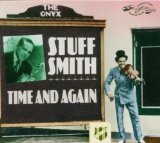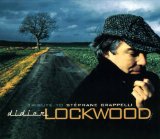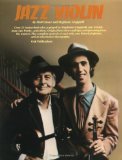
MENU TO FIDDLE STYLES:
Jazz Violin
This page has moved. Please GO HERE
What Stuff Smith lacks in tone and finesse he more than makes up for with melodic and rhythmic invention, and the sheer force of his playing. This collection gives you an excellent overview of his playing at the peak of his career.
Disk one covers the period 1935-39, and is mostly with his Onyx Club Boys line-up. The majority are vocal numbers, with Smith displaying his “Jive Talkin’” humour that you might be more familiar with from the likes of Louis Jordan. I’s a Muggin is one such number, a big hit for Stuff which was covered by Grappelli and Reinhardt, among others. The solos tend to be short, but some, such as Old Joe’s hittin the Jug, are exceptional; the “outsidedness” of his playing shows him as a player well ahead of his time. The fireworks really start on disk 2, which is mostly instrumental numbers recorded with his trio (with piano and bass) between 1940 and 45. The bebop influence on his playing is clear in numbers such as The Red Jumps, and his playing is full of excitement and danger, peppered throughout with parallel fifths and strident octave licks. We get no less than three versions of Desert Sands, a Smith composition which became something of a theme tune, almost certainly influenced by the Duke Ellington hit Caravan. With 49 tracks, and a 15-page booklet this is terrific value. If you buy nothing else by Stuff Smith, this is the one to get.
Tribute to Stephanie Grappelli

If I had to recommend a single cd of jazz violin of all the ones I’ve ever listened to, this would be it. Lockwood was a protégé of Grappelli in the 1970’s, and absorbed many of the most endearing stylistic traits of the older player. This is heard most clearly on the slow ballads such as Les Valseuses, My one and Only Love. Misty and Tears, where the breathy tone and broken phrasing are pure Grappelli. Lockwood’s rendition of Nuages is the one I always play to students to demonstrate his absolute mastery of harmonics, both natural and artificial, as well as the way in which such incredible depth and expression can be squeezed into 32 bars of melody. Didier Lockwood may once have been a Grappelli disciple, but this album clearly demonstrates that he is his own man, and his playing has moved many steps beyond his former mentor. The faster tracks, such as I Got Rhythm, Pent up House and All the Things you Are, show a strong bebop sensibility, with carefully judged “outside” playing, while Barbizon Blues and The Kid are cool and funky.
The most unique aspect of Lockwood’s playing is his bow control. Every note of a phrase is given the clearest articulation, but between phrases he often takes all the pressure off the bow, and makes little slides, gasps and sighs which make his violin into a living, breathing thing, and a very sexy one at that. I don’t give star ratings for cd’s; even if I did, there wouldn’t be enough in the sky for this one.
Since its publication in 1981, this must have been one of the most popular jazz violin books on the market. Put together by Matt Glaser, former chair of strings at Berklee College, and now director of Roots Music there, it contains faithful transcriptions of 24 Grappelli solos, plus others by Venuti, Ponty, South. Asmussen and Smith. There are also interviews with Grappelli , Ponty and Yehudi Menuhin. There is analysis of each solo and a table of common motifs, and there are comparisons of different solos for the same tune. Glaser makes a good choice of numbers, using classics such as It Don't Mean a Thing, Dinah, Lady be Good, Undecided and Sweet Georgia Brown.
To get the most out of this book you will need a lot of patience to work through the transcriptions, and to get hold of some of the original recordings. Transcription of solos is an essential part of any jazz student's labour, and here Glaser has saved us all a great deal of effort!
Mel Bay Jazz Fiddle Wizard Book/CD Set
This is one of the most useful jazz tutors I've come across, particularly if you're interested in the more modern end of jazz fiddling. He starts off describing the invaluable bebop scales, where an extra chromatic note in the scale starts each new bar with a chord note on the beat. He talks about chord analysis, inner melodies, and the importance of avoiding starting chord arpeggios on the root. The section I found most useful was a series of II/V/I patterns with altered notes; sharpened and flattened ninths for example, giving a cool, modern, slightly outside sound.





